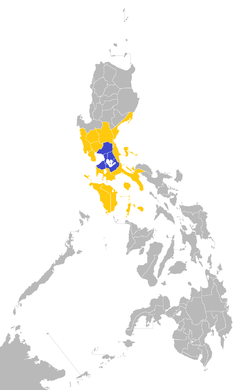Mega Manila | |
|---|---|
 Manila (proper) skyline | |
 Location of Mega Manila within the Philippines: blue (for the Greater Manila Area) and yellow, according to the Philippine Information Agency | |
| Country | |
| Regions | Calabarzon Central Luzon Metro Manila Mimaropa (except Palawan) |
| Area | |
| • Metro | 50,525 km2 (19,508 sq mi) |
| Population | |
| • Metro | 41,099,507 |
| • Metro density | 810/km2 (2,100/sq mi) |
| GDP | |
| • Metro | ₱ 14.131 trillion US$ 254.364 billion (2023) |
| • Per capita | ₱ 345,000 US$ 6,200 (2023) |

Mega Manila is a megalopolis on the island of Luzon in the Philippines. There are varying definitions of the megalopolis, but it is generally seen as encompassing the administrative regions of Central Luzon, Calabarzon, and Metro Manila. On some occasions, the administrative region of Mimaropa (excluding Palawan) is also included.
It is frequently used in the press, advertising, television, and radio to refer to provinces bound to Manila, in contrast to the term Greater Manila Area, which is academically used to describe the urbanization process that has long spilled out of Metro Manila's borders, also known as the built-up area. Mapping out the built-up area around Manila requires finer granularity than the more generic term Mega Manila.
It is also being used more and more recently in planning for infrastructure projects by the government, particularly by the National Economic and Development Authority (NEDA) and the Japan International Cooperation Agency (JICA).
Mega Manila is used in general reference to the relationship of Metro Manila to the surrounding provinces. It references only provinces and not the exact settlement patterns of cities, towns, and barangays, which may be urban, suburban, mountainous, or rural areas that are still part of provinces close enough to Manila to be lumped into the definition.
- ^ "2021 to 2023 Gross Regional Domestic Product (GRDP)". Philippine Statistics Authority. Retrieved April 26, 2024.
